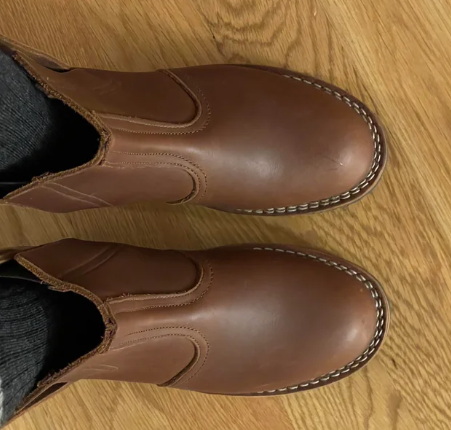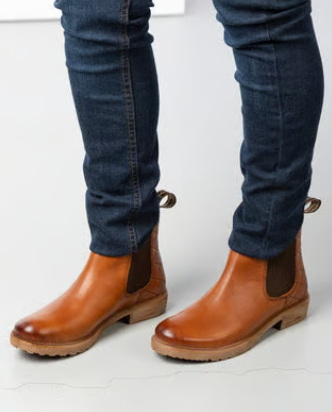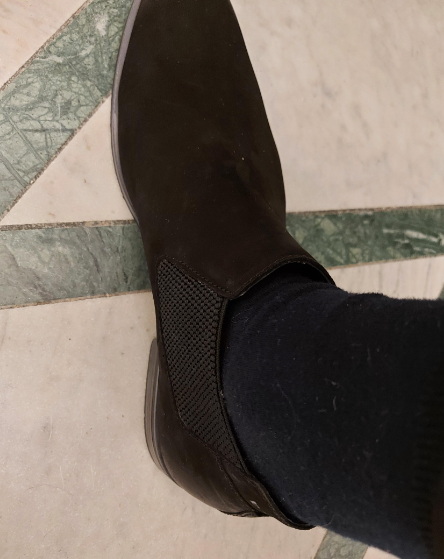Content Menu
● Introduction to Chelsea Boots
>> Key Features of Chelsea Boots
● Methods for Removing Chelsea Boots
>> 1. The Traditional Hand Pull Method
>> 2. Using a Boot Jack
>> 3. Using a Shoehorn
>> 4. The "Kick-Off" Method
>> 5. Removing the Insole
>> 6. Adjusting Your Socks
● Breaking In Chelsea Boots
>> 1. Wear Them Regularly
>> 2. Use a Leather Conditioner
>> 3. Massage the Heel
>> 4. Avoid Overheating
● Caring for Chelsea Boots
>> 1. Regular Cleaning
>> 2. Conditioning
>> 3. Waterproofing
>> 4. Storage
● Conclusion
● FAQ
>> 1. Why are Chelsea boots hard to remove?
>> 2. Can I damage my Chelsea boots by pulling them off too hard?
>> 3. How often should I condition my Chelsea boots?
>> 4. Is it okay to use a hair dryer to stretch my Chelsea boots?
>> 5. What is the best way to store my Chelsea boots?
● Citations:
Chelsea boots are a timeless and versatile footwear choice, known for their sleek design and comfortable fit. However, one common challenge many users face is the difficulty in removing them, especially when they are new. This article will guide you through various methods and tips on how to take off Chelsea boots easily, along with advice on how to break them in and maintain their quality.

Introduction to Chelsea Boots
Chelsea boots are characterized by their elastic side panels, close-fitting ankle, and minimalist design. They originated in the Victorian era and have since become a fashion staple for both men and women. The snug fit around the ankle contributes to their stylish look but can also make them difficult to remove.
Key Features of Chelsea Boots
- Elasticated Sides: These allow for easy slipping on and off without laces.
- Ankle Height: Designed to reach just above the ankle, providing coverage and support.
- Low Heel: Suitable for walking and everyday wear.
Methods for Removing Chelsea Boots
Removing Chelsea boots can be challenging, especially when they are new. Here are some effective methods to help you take them off with ease:
1. The Traditional Hand Pull Method
This is the most common method for removing Chelsea boots. It involves using your hands to grip the boot and pull it off your foot.
1. Sit Down: Find a comfortable place to sit. This provides stability and leverage.
2. Grip the Boot: Hold the back of your ankle with one hand and grab the toe with the other hand.
3. Pull and Wiggle: Gently pull the boot while wiggling your foot. Alternate between pulling and wiggling to gradually ease the boot off your heel.
4. Repeat: Repeat the process until the boot is completely removed.
2. Using a Boot Jack
A boot jack is a handy tool designed to help remove boots easily and quickly without damaging them.
1. Position the Boot Jack: Place the boot jack on the floor with the U-shaped opening facing away from you.
2. Place Your Foot: Put your non-booted foot on the flat end of the boot jack to hold it in place.
3. Insert Heel: Slide the heel of your booted foot into the U-shaped opening.
4. Pull Out: Pull your foot out of the boot while the boot jack holds the boot securely.
5. Repeat: Repeat with the other foot.
3. Using a Shoehorn
A shoehorn can assist in reducing friction between your heel and the boot.
1. Insert Shoehorn: Slide the shoehorn between your heel and the back of the boot.
2. Wiggle Foot: Wiggle your foot while holding the shoehorn in place.
3. Pull Off: Gently pull the boot off, using the shoehorn to guide your heel.
4. The "Kick-Off" Method
This method involves using the opposite foot to push down on the heel of the boot you want to remove. However, it should be used with caution to avoid damaging the boots.
1. Sit or Stand: Find a stable position, either sitting or standing.
2. Position Heel: Use the opposite foot to push down on the heel of the boot.
3. Kick Forward: Simultaneously kick your foot forward while pushing down on the heel.
4. Control Force: Use minimal force to avoid damaging the boot's sole or heel.
5. Removing the Insole
Removing the insole can create more space inside the boot, making it easier to slide your foot out.
1. Remove Insole: Carefully take out the insole from the boot.
2. Try Again: Attempt to remove the boot using one of the methods described above.
3. Replace Insole: Once the boot is off, replace the insole for regular wear.
6. Adjusting Your Socks
Sometimes, the issue isn't the boot itself, but the socks you're wearing.
1. Adjust Socks: Make sure your socks are not bunched up around your toes or heel.
2. Smooth Out: Smooth out any wrinkles or folds in your socks to reduce friction.
3. Try Again: Attempt to remove the boot using one of the methods described above.

Breaking In Chelsea Boots
New Chelsea boots often require a break-in period. Here are some tips to help soften the leather and make them easier to remove:
1. Wear Them Regularly
- Gradual Wear: Wear your Chelsea boots for short periods initially, gradually increasing the wear time.
- Thick Socks: Use thick socks to protect your feet from rubbing against the leather.
2. Use a Leather Conditioner
Apply a leather conditioner to soften the leather and make it more pliable. This helps the leather mold to your feet over time.
3. Massage the Heel
Gently massage the heel part of the boots with your hands to help break them in.
4. Avoid Overheating
Avoid using excessive heat, such as a hair dryer, as this can cause damage to the leather.
Caring for Chelsea Boots
Proper care is essential to maintain the quality and appearance of your Chelsea boots.
1. Regular Cleaning
- Soft Cloth: Clean your boots regularly with a soft cloth or leather cleaner.
- Avoid Excess Water: Don't soak the leather, as excess water could damage it.
2. Conditioning
Apply a leather conditioner to prevent the leather from drying out and cracking.
3. Waterproofing
Use a waterproof spray to protect your boots from moisture and stains.
4. Storage
Store your Chelsea boots in a cool, well-ventilated place away from direct sunlight and heat. Use shoe trees to help maintain their shape.
Conclusion
Removing Chelsea boots can be challenging, especially when they are new. However, by using the right techniques and tools, such as a boot jack or shoehorn, you can make the process easier and prevent damage to your boots. Breaking in your boots properly and maintaining their leather will ensure they remain a stylish and comfortable part of your wardrobe for years to come.

FAQ
1. Why are Chelsea boots hard to remove?
Chelsea boots are hard to remove due to their snug fit around the ankle and the stiffness of new leather. Over time, the leather will soften and stretch, making them easier to take off.
2. Can I damage my Chelsea boots by pulling them off too hard?
Yes, excessive force can damage your Chelsea boots. Pulling too hard can stress the seams, elastic panels, and the connection between the sole and the upper. It's best to use gentle, controlled movements and assistive tools like a boot jack or shoehorn.
3. How often should I condition my Chelsea boots?
You should condition your Chelsea boots every few months, or whenever the leather starts to feel dry. Regular conditioning helps keep the leather soft and supple, preventing cracks and extending the life of your boots.
4. Is it okay to use a hair dryer to stretch my Chelsea boots?
Using a hair dryer can help soften the leather and make it more pliable, but it should be done with caution. Use a low heat setting and avoid holding the hair dryer too close to the leather, as excessive heat can cause damage.
5. What is the best way to store my Chelsea boots?
Store your Chelsea boots in a cool, well-ventilated place away from direct sunlight and heat. Use shoe trees to help maintain their shape and prevent creases. Avoid storing them in plastic bags, as this can trap moisture and lead to mold growth.
Citations:
[1] https://www.reddit.com/r/BlundstoneBoots/comments/1cge1to/can_we_talk_about_how_hard_these_boots_are_to_get/
[2] https://chelseabootstore.com/what-is-a-boot-jack/
[3] https://chelseabootstore.com/how-to-break-in-your-chelsea-boots/
[4] https://www.yinghuafootwear.com/how-to-remove-chelsea-boots.html
[5] https://www.youtube.com/watch?v=MiH9aXMYCnA
[6] https://woodbootjack.com/how-to-use-a-boot-jack/
[7] https://www.ahume.co.uk/blog/chelsea-boots-the-ultimate-buyers-guide/
[8] https://www.panamajack.de/en/blogs/news/how-to-clean-chelsea-boots
[9] https://www.shoezone.com/Blog/the-low-down-on-chelsea-boots
[10] https://nicksboots.com/blog/post/chelsea-work-boots/
[11] https://www.youtube.com/watch?v=40CyncMmZkc
[12] https://www.blundstone.com/how-to-break-in-chelsea-boots
[13] https://www.instagram.com/leshoeguy/reel/Cn98zeWj5L2/?hl=en
[14] https://www.oswinhyde.com/blogs/news/caring-for-your-chelsea-boots-tips-to-maintain-their-elegance
[15] https://www.tiktok.com/discover/taking-off-doc-martens-chelsea-boots
[16] https://www.tiktok.com/discover/how-to-break-in-chelsea-boots
[17] https://www.crockettandjones.com/collections/mens-chelsea-boot-collection
[18] https://www.muji.com.hk/en/product/4550584120695
[19] https://www.doppelganger.it/en/mens-chelsea-boots-in-100-genuine-leather-with-rubber-soles-8800016762082.html
[20] https://www.youtube.com/watch?v=LKQ-YqwmSsI
[21] https://www.doppelganger.it/en/chelsea-boots---suede---100-leather-8800013167040.html
[22] https://www.rmwilliams.com.au/the-boot-jack.html?lang=en_AU
[23] https://www.moonboot.com/en/ch/LUNA-GREY-SUEDE-CHELSEA-BOOTS/80D2480050-H005.html
[24] https://www.facebook.com/heartofthesouthms/videos/easily-remove-your-boots-with-the-boot-jack-simply-step-on-the-back-with-one-foo/153357556098334/
[25] https://www.jilsander.com/en-hk/chelsea-boots/J15WU0066P2775001.html
[26] https://www.facebook.com/ragenbd/videos/stepping-out-in-styleeffortless-and-bold-most-awaited-chelsea-boots-available-in/888709286361208/
[27] https://www.reddit.com/r/goodyearwelt/comments/3qkcru/could_somebody_explain_chelsea_boots_for_me/
[28] https://www.themodestman.com/how-to-wear-chelsea-boots-for-men/
[29] https://www.youtube.com/watch?v=T8idG4nxeTM
[30] https://lussolifestyle.com/blogs/blogs-by-lusso/are-chelsea-boots-formal
[31] https://www.cheaney.co.uk/blog/a-guide-to-chelsea-boots-your-new-favourite-boot-for-every-day/
[32] https://www.youtube.com/watch?v=SOcwD5_2k1U
[33] https://www.reddit.com/r/Boots/comments/1fwriqm/help_removing_staindiscoloration_on_cheap_chelsea/
[34] https://www.sumissura.com/en/blog/how-to-style-chelsea-boots
[35] https://chelseabootstore.com/shoe-care-guide/
[36] https://www.timberland.com/en-us/faq/what-is-a-chelsea-boot
[37] https://www.youtube.com/watch?v=R37v_lIYFO0
[38] https://leatherhero.com.au/pages/how-to-restore-scuffed-chelsea-boots
[39] https://www.shutterstock.com/search/remove-shoes
[40] https://www.youtube.com/watch?v=J9rjCZznits
[41] https://www.shutterstock.com/search/chelsea-boots
[42] https://www.vogue.com/article/chelsea-boots
[43] https://hollandscountryclothing.co.uk/collections/boot-jacks
[44] https://terilynadams.com/how-to-style-chelsea-boots/

















